Sushi and sashimi are two of the most famous Japanese dishes, enjoyed by people all over the world. While these two dishes are often used interchangeably, they are actually quite different. Sushi typically consists of vinegared rice mixed with other ingredients, including raw or cooked seafood, vegetables, and eggs. And sashimi is thinly sliced raw fish, without rice. We are exploring the differences between sushi and sashimi. What are some common types of each dish, and the cultural significance of these culinary traditions. Whether you are a seasoned sushi and sashimi lover or just discovering these dishes for the first time, this article will provide valuable insight into the world of Japanese cuisine.
The importance of Japanese etiquette when eating sushi and sashimi
Japanese culture places a great emphasis on manners and etiquette. And this is particularly true when it comes to eating sushi and sashimi. Following proper etiquette not only shows respect for the food but also for the chef who prepared it. When dining at a sushi restaurant, it’s important to understand the traditional customs and practices. For example, using chopsticks properly and not playing with them is a sign of respect. Similarly, dipping the fish side of the sushi into soy sauce is a way to show appreciation for the delicate flavors of the fish. By following these customs and practices, you can fully appreciate the culinary artistry of sushi and sashimi.
The Difference between Sushi and Sashimi
What is sushi and what is sushimi
Sushi and sashimi may look similar at first glance, but they are actually quite different dishes. Sushi is a Japanese dish made from vinegared rice, usually combined with raw fish, seafood, or vegetables, and sometimes wrapped in seaweed. Also, sushi can come in a variety of forms. Some of them include nigiri (small rice balls topped with fish), maki (rolled sushi), and temaki (hand rolls).
On the other hand, sashimi is a dish consisting of thinly sliced raw fish, served without rice. Unlike sushi, which can contain a variety of ingredients, sashimi is typically from high-quality seafood, such as tuna, salmon, or octopus. While both dishes sushi enthusiasts around the world love, they are distinct and separate culinary traditions with unique flavors, textures, and presentations.
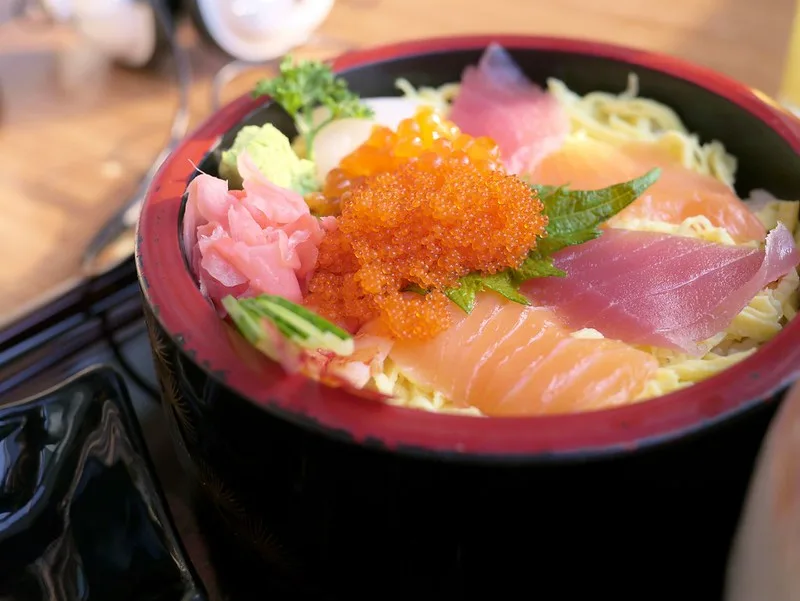
Some common types of sushi:
Nigiri Sushi: hand-pressed sushi rice topped with raw fish or other seafood.
Maki Sushi: sushi rolls that typically include rice, seaweed, and various fillings such as fish, vegetables, or eggs.
Temaki Sushi: also popular as a hand roll, this is a cone-shaped sushi roll that is typically filled with rice, fish, and vegetables.
Uramaki Sushi: sushi rolls that have rice on the outside and seaweed on the inside, with various fillings.
Inari Sushi: sushi rice stuffed inside a sweet and savory fried tofu pouch.
Chirashi Sushi: a type of sushi bowl that includes sushi rice topped with various ingredients such as sashimi, vegetables, and egg.
Oshi Sushi: a type of sushi that is made by pressing layers of sushi rice and various toppings into a rectangular shape.
Best places to try sushi in Japan
Tsukiji Fish Market in Tokyo: The Tsukiji Fish Market was one of the largest seafood markets in the world before it moved to Toyosu Market in 2018. Here you can find a wide variety of sushi restaurants and stalls serving up the freshest sushi made with the catch of the day.
Sushi Dai in Tokyo. You can find it in the Tsukiji Fish Market area. Sushi Dai is a popular sushi restaurant famous for its fresh and delicious sushi. You’ll probably wait in line for a seat, but the experience is worth it.
Daiwa Sushi in Tokyo, Another popular sushi restaurant in the Tsukiji area. Daiwa Sushi is famous for its omakase (chef’s choice) course that features a variety of fresh sushi made with the catch of the day.
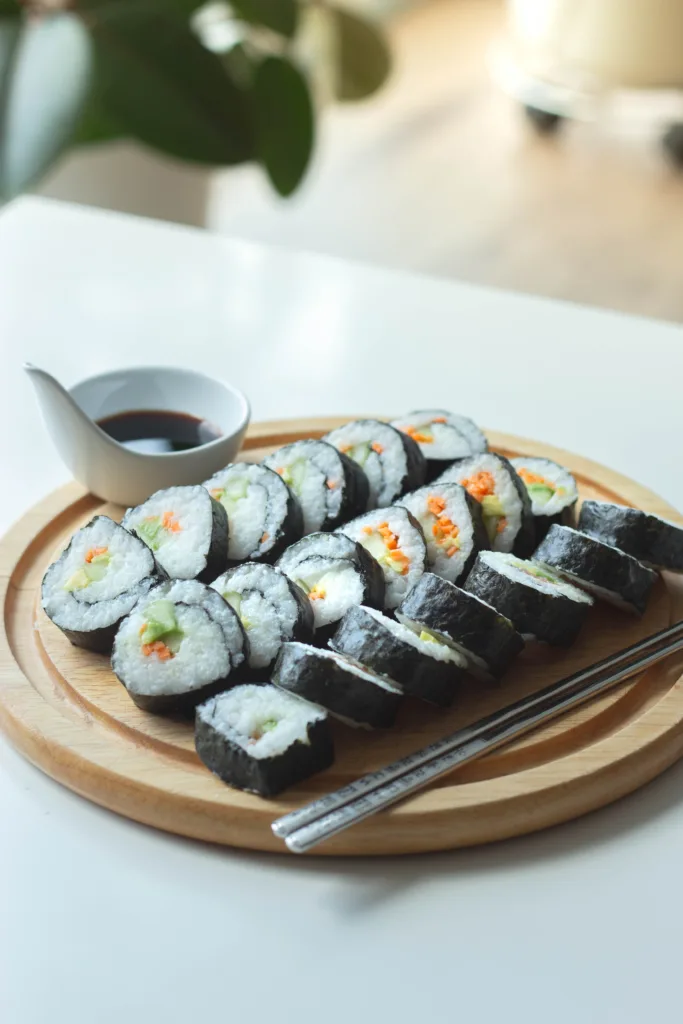
Some common types of sashimi:
Sashimi is a Japanese dish consisting of thinly sliced raw fish or seafood, served with soy sauce and wasabi.
Maguro (Tuna): one of the most popular types of sashimi. Maguro often comes as a bright red or pink slice of raw tuna.
Sake (Salmon): another popular type of sashimi, sake usually comes as a bright orange slice of raw salmon.
Hamachi (Yellowtail): this sashimi is made from raw yellowtail, which has a rich, buttery flavor.
Tai (Sea Bream): a type of white fish sashimi that has a mild and slightly sweet flavor.
Hotate (Scallop): sweet and succulent, raw scallop sashimi often comes with a light dressing of soy sauce and citrus.
Ebi (Shrimp): raw shrimp sashimi usually comes with the head and tail still attached and has a delicate texture and flavor.
Uni (Sea Urchin): a creamy and buttery sashimi made from the roe of sea urchins.
Best places to try sushi in Japan
Tsukiji Fish Market in Tokyo: The Tsukiji Fish Market is one of the best places to try a wide variety of sashimi in Tokyo. Here you can find fresh and delicious sashimi made with the catch of the day.
Kanazawa Central Market in Ishikawa Prefecture: The Kanazawa Central Market is a bustling market that is famous for its fresh seafood, including a wide variety of sashimi. It’s a great place to try local seafood and sashimi specialties.
Shiogama Seafood Wholesale Market in Miyagi Prefecture: Located in the city of Shiogama, the Shiogama Seafood Wholesale Market is one of the largest fish markets in the Tohoku region. Here you can find a wide variety of fresh and delicious sashimi made with local seafood.
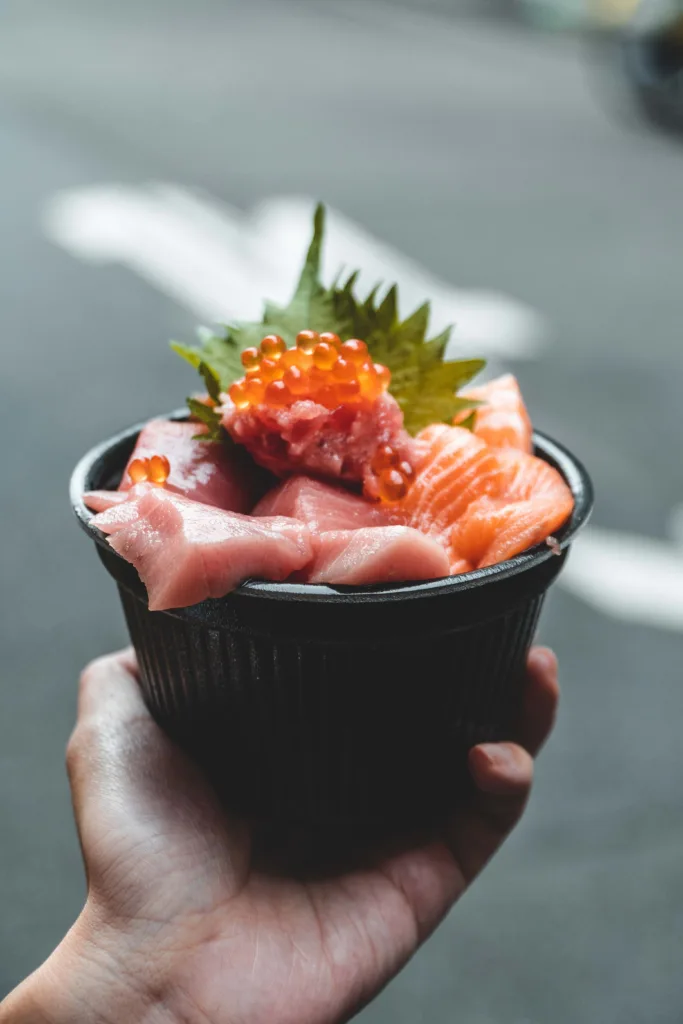
The Importance of Clean Flavors
Clean flavors are very important in Japanese cuisine, particularly when it comes to sushi and sashimi. The focus is on highlighting the natural flavors of the ingredients, rather than masking them with heavy sauces or seasonings. The goal is to create a balance of flavors and textures that are pleasing to the palate. This emphasis on clean, simple flavors shows respect for the ingredients themselves. But also as a desire to provide diners with a dining experience that is both satisfying and nourishing.
In Japanese culture, the concept of shibui is very important. Shibui refers to a kind of understated elegance through simplicity and restraint. You can see this concept in the approach to cooking and dining as well. Here the goal is to create dishes that are clean and uncluttered. That allows the natural flavors of the ingredients to shine through. Clean flavors are also an important part of Japanese health and wellness practices. It emphasizes the benefits of whole foods and natural ingredients. By avoiding heavy sauces and excessive seasoning, Japanese cuisine is able to offer a healthier alternative that is still satisfying and flavorful.
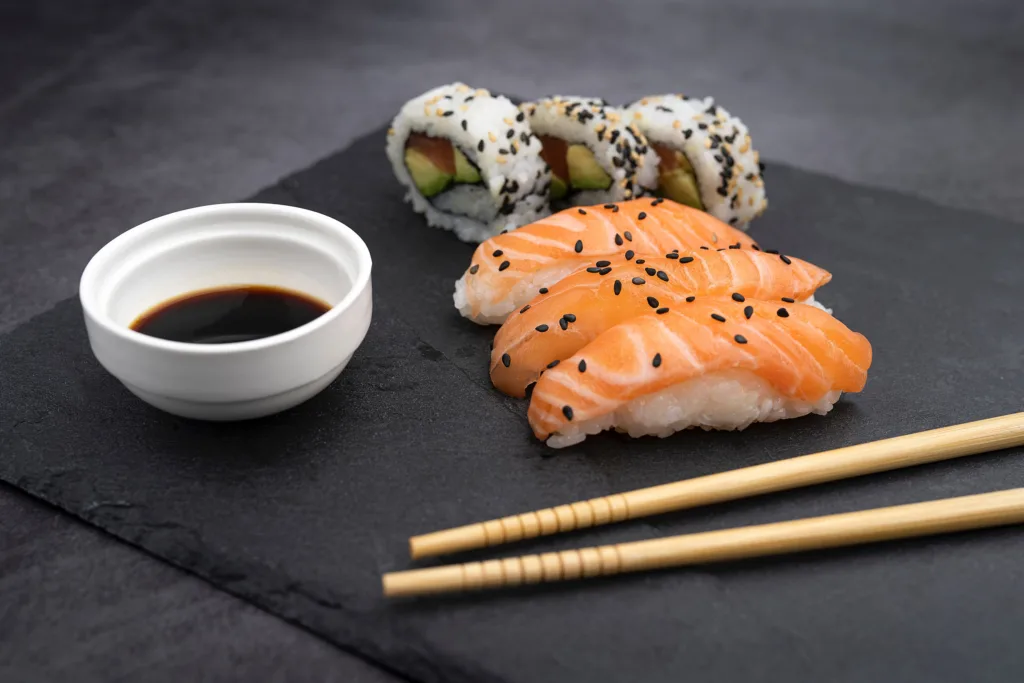
The proper way to use ginger, soy sauce, and wasabi while eating sushi and sashimi
When enjoying sushi and sashimi, it is important to use sauces properly to fully appreciate the clean flavors.
Ginger typically comes alongside sushi and sashimi as a palate cleanser between bites. You should never use it as a topping. Instead, take a small piece of ginger and place it on your tongue before moving on to the next piece of sushi or sashimi. You should use soy sauce sparingly, with just a small amount of sauce being poured into a shallow dish. When you dip sushi, it is important to keep the fish side down and only slightly dip it into the soy sauce. Avoid mixing wasabi and soy sauce, as this can overpower the delicate flavors of the dish. Instead, if you desire some additional heat, add a small amount of wasabi directly to the fish or rice. Use these condiments in the proper way, so you can fully appreciate the nuanced flavors of sushi and sashimi.
The proper way to use chopsticks while eating sushi and sashimi
Using chopsticks is an important aspect of eating sushi and sashimi the Japanese way. When it comes to sushi, you should eat nigiri with your fingers while rolls you should eat with chopsticks. For sashimi, chopsticks you should always use. Take note if you play with chopsticks or rub them together to get rid of splinters as it is rude in Japan. When you pick up a piece of sushi or sashimi with chopsticks, do so gently, without squeezing the rice or fish. Additionally, don’t pass food from one set of chopsticks to another as it is impolite. So be sure to transfer food directly onto your own chopsticks before eating.
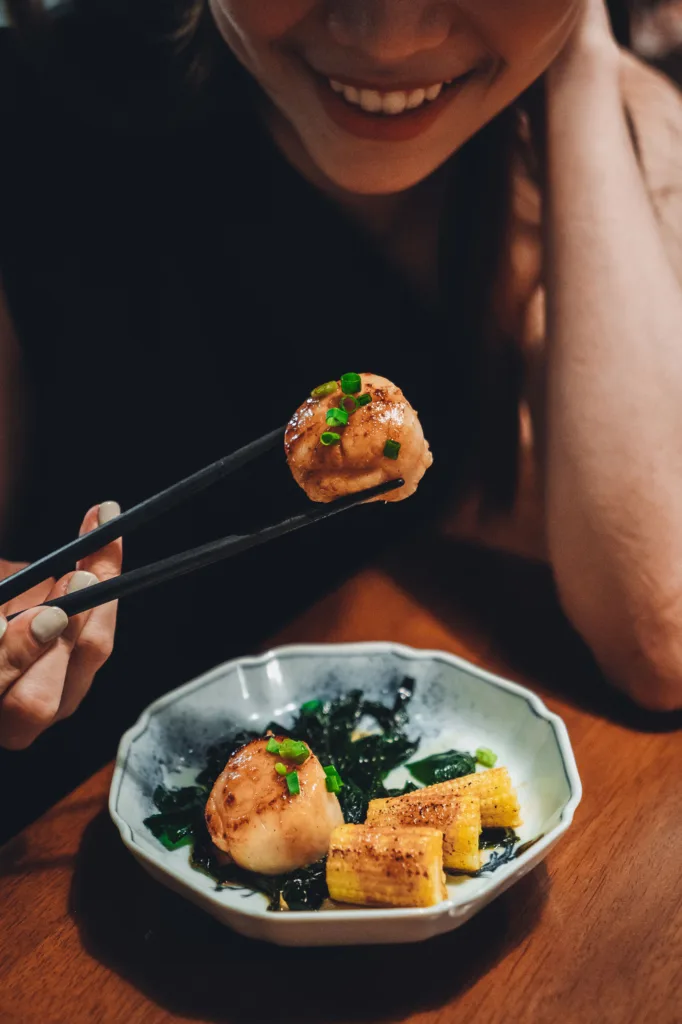
Finger food vs. chopsticks when eating sushi
When it comes to eating sushi the Japanese way, there is a distinction between finger food and chopstick food. Nigiri sushi, which is a small piece of fish on top of a ball of sushi rice, you should eat with your fingers. This is because the warmth of the hand enhances the flavors of the fish and rice. On the other hand, sushi rolls typically go with chopsticks because they can be difficult to pick up with the fingers. However, if the sushi roll is small enough, you can eat it with your fingers. In general, it is important to be mindful of the type of sushi you eat. And also the cultural norms surrounding its consumption, in order to fully appreciate and respect the traditional Japanese dining experience.
How to dip sushi in soy sauce
Dipping sushi in soy sauce is a delicate process. You should do it with care in order to fully appreciate the flavors of the sushi. Lightly dip the fish side of the sushi into the soy sauce while avoiding getting any sauce on the rice. It’s because the rice has already been seasoned with vinegar and adding soy sauce may overpower the subtle flavors of the sushi. Avoid adding too much soy sauce, as it can make the sushi too salty and mask the natural flavors. In essence, dipping sushi in soy sauce should be a simple and subtle act that enhances, rather than overwhelms flavors.
Traditional Sushi and Sashimi
Traditional sushi and sashimi are popular for their simple yet refined flavors. At a traditional sushi bar, you can expect to find fish and rice with a minimal amount of seasoning. Usually just a touch of wasabi or soy sauce. These establishments pride themselves on showcasing the natural flavors of the fish and rice, rather than masking them. You won’t find many fusion options at traditional sushi bars, as they prefer to stick to classic techniques and flavors.
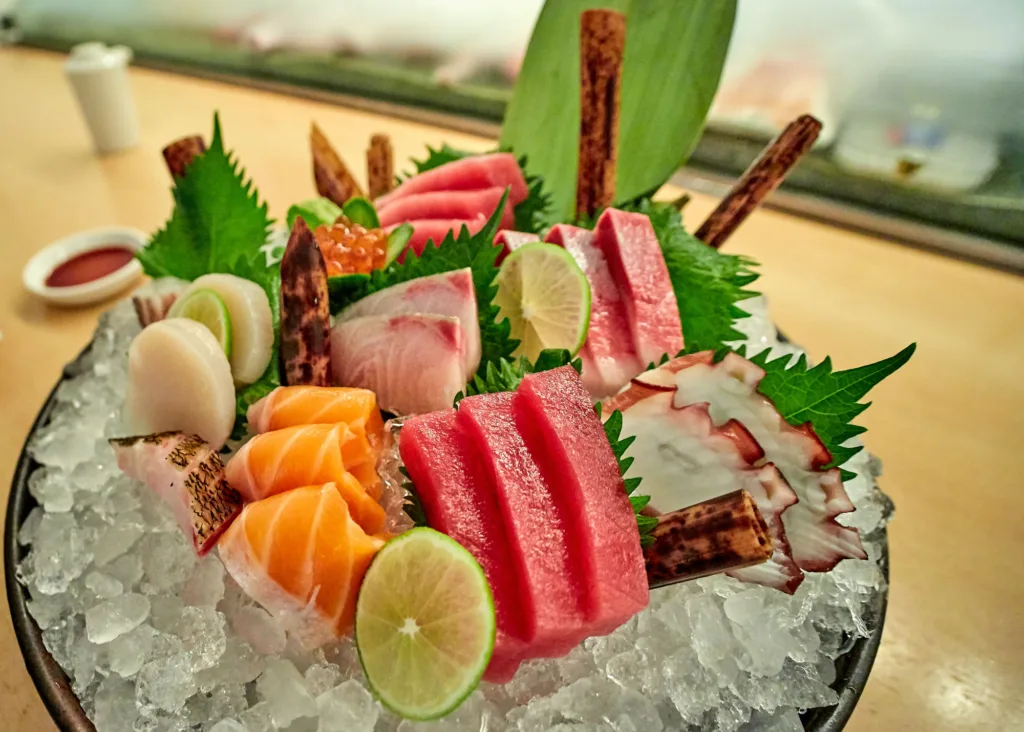
What to expect when eating sushi and sashimi at a traditional or fine-dining sushi bar
When eating sushi and sashimi at a traditional place, you can expect a minimalistic approach to the dishes. The focus is on showcasing the quality of the ingredients and the skill of the chef. Sushi typically consists of a small ball of seasoned rice topped with a piece of fresh fish or other seafood. Sashimi is served as thinly sliced raw fish or other seafood without rice. The dishes may come with a small amount of wasabi, soy sauce, and pickled ginger. And the emphasis is on the clean flavors of the fish and rice. The atmosphere is often quiet and serene, allowing diners to savor the delicate flavors in a peaceful setting.
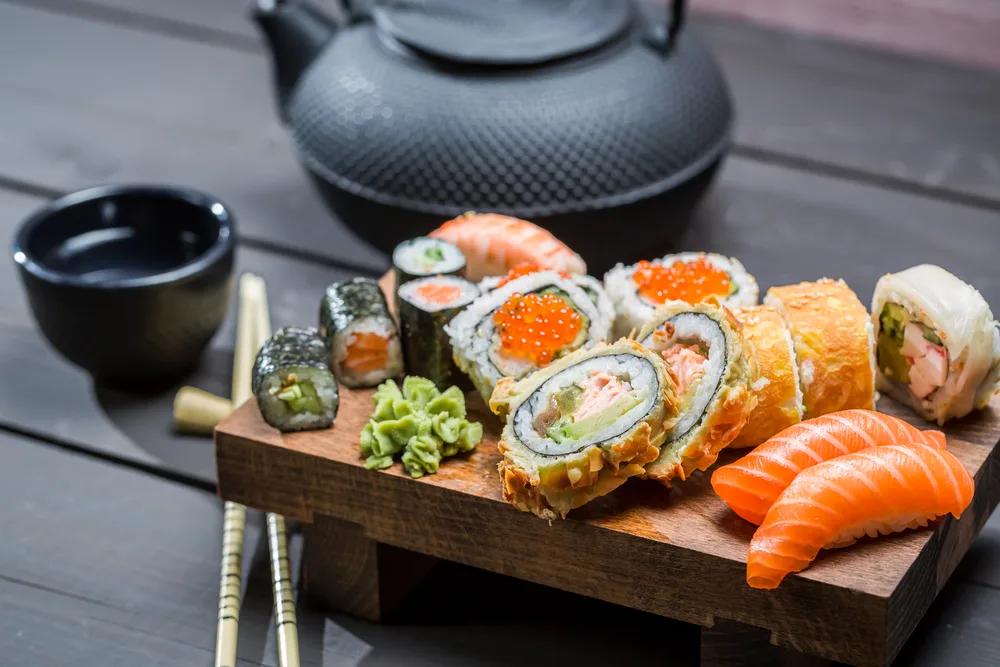
Tipping Etiquette
Tipping is a common practice in many parts of the world, but in Japan, it’s a different story. The country has a unique culture that places a great deal of emphasis on hospitality and service. In Japanese restaurants, tipping is not expected, and in some cases, it can even be considered rude.
Tipping etiquette in Japanese restaurants
In Japan, there is a strong sense of pride in providing excellent service to customers. Waitstaff and servers are trained to provide impeccable service, and they take pride in their work. As such, they do not expect to receive tips from customers. In fact, leaving a tip can be seen as an insult. To Japanese, it implies that the server is not already doing its job to the best of its ability. Additionally, tipping can create a sense of obligation or indebtedness, which is not a part of Japanese culture.
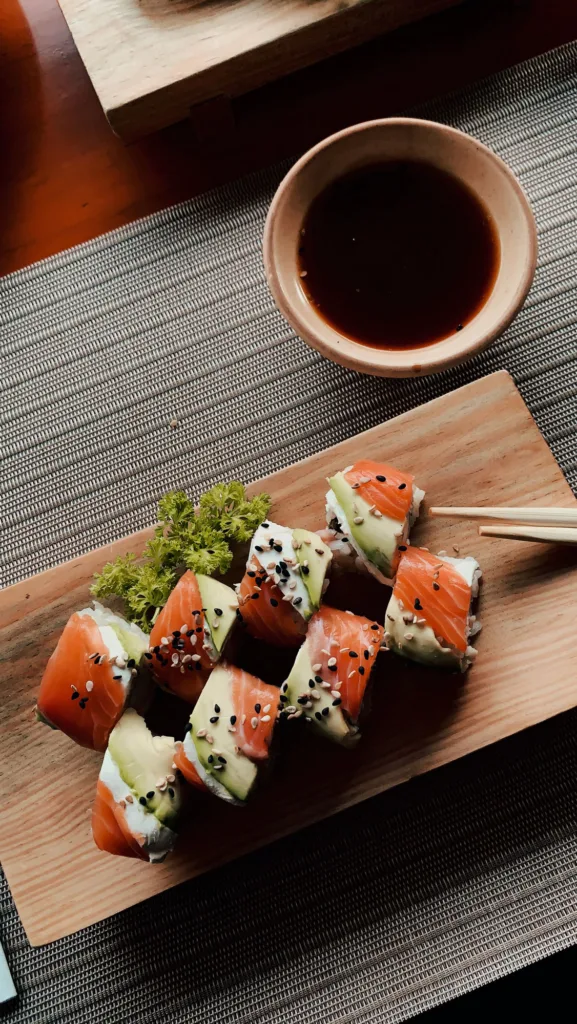
Enjoying sushi and sashimi the Japanese way means appreciating the simplicity and purity of the flavors. If you follow proper etiquette, you can fully savor the delicate tastes of the fish and rice. Whether you choose to eat with chopsticks or your fingers, remember to keep the fish side down when dipping in soy sauce, and use ginger for cleansing your palate. When dining at a traditional or fine-dining sushi bar, be prepared for a minimalist menu without fusion options. And lastly, keep in mind that tipping is not expected, but showing gratitude and respect to your server is always appreciated.
Embrace Japanese customs and etiquette, so you can fully enjoy the art of sushi and sashimi.
Ready to make sushi at home?
If you’re planning to make sushi and sashimi at home, here are some essentials to consider:
- Sushi-grade fish: The most important ingredient for sushi and sashimi is the fish. It’s essential to use sushi-grade fish. Look for a reputable fishmonger or online supplier that specializes in sushi-grade fish.
- Sushi rice: Sushi rice is short-grain rice that is sticky and perfect for making sushi rolls. You can find sushi rice at most grocery stores or online. Follow the instructions on the package to cook the rice properly.
- Sushi-making tools: You’ll need a few basic tools to make sushi at home, including a bamboo rolling mat, a sharp knife, and a bowl of water for dipping your fingers in to prevent the rice from sticking.
- Ingredients for sushi rolls: You can get creative with the fillings for your sushi rolls. Some popular options include avocado, cucumber, crab meat, shrimp, salmon, and tuna. You can also add condiments like wasabi, soy sauce, and pickled ginger.
- Ingredients for sashimi: Sashimi is simply slices of raw fish or seafood. You’ll need high-quality sushi-grade fish and a sharp knife to slice it thinly.
- Presentation: Finally, consider how you’ll present your sushi and sashimi. Arrange the pieces on a platter or sushi board, and add some decorative touches like edible flowers or sesame seeds for a visually appealing presentation.
For those curious to learn more about Japanese Cuisine
For those curious to read more about Washoku, the traditional cuisine of Japan, there are several excellent books available that delve into the history, culture, and techniques behind this fascinating culinary tradition. Here are five top book recommendations:





Experience the culture and cuisine of Japan firsthand
Sushi and sashimi are an integral part of Japanese cuisine, with a rich history and culture behind them. From the preparation and presentation to the use of fresh, high-quality ingredients, the Japanese approach to sushi and sashimi is all about simplicity and respect for the natural flavors of the seafood. Whether you’re enjoying classic nigiri sushi or exploring the flavors of different sashimi types, experiencing these traditional Japanese dishes is a true culinary delight that you should savor with every bite.
If you’re ready to experience the culture and cuisine of Japan firsthand, start planning your trip today and explore all that this amazing country has to offer
